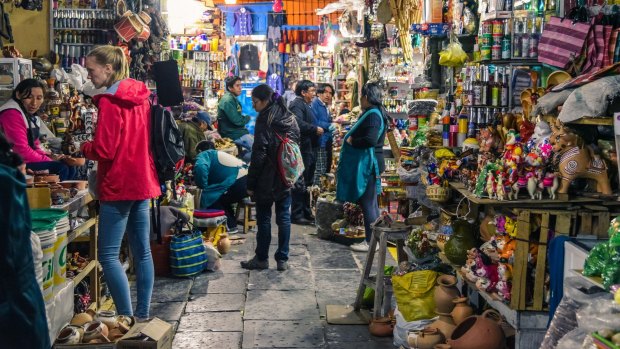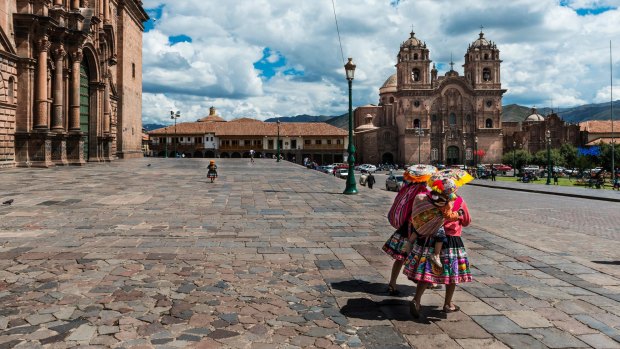By Mark Daffey

The colourful San Pedro market in Cusco. Credit: Alamy
Some cities and towns around the world have a knack of attracting foreign visitors in their droves. From Kathmandu to Luang Prabang, or Hoi An to Byron Bay, for reasons that are many and varied, travellers are drawn to them like controversy finds Donald Trump.
In Peru, that place is undoubtedly Cusco, the former Inca stronghold that arguably ranks as the gringo capital of the world. Stroll around the Plaza de Armas, where colonial-era buildings containing modern restaurants and bars surround park gardens shadowed by ornate churches and cathedrals, and you'll hear accents ranging from Spanish to Japanese and Hebrew.

Two women wearing traditional clothes walking in the Plaza de Armas, in Cusco.Credit: Alamy
Travel agents tout hiking trips along the Inca Trail or excursions into the Amazon jungle. Souvenir outlets hock panpipes and stuffed alpacas. Sideboards advertise massage services. Squat women with leathery faces beneath bowler hats point to your camera, imploring you to photograph them – for a fee.
Few other destinations figure as prominently on traveller's itineraries in a single country like Cusco does. Once the centre of the Americas' largest known empire, its architecture blends traditional with colonial in a style that can be found nowhere else. It is nestled among magnificent Andean scenery. Its markets are lively and its nightlife hums. Michelin-starred chefs fuse local dishes with foreign influences. But more than anything, perhaps, Cusco has the good fortune of being the gateway to the Sacred Valley and the "lost city" of Machu Picchu.
According to Central Reserve Bank of Peru figures released in November 2018, the number of foreign visitors to the Cusco region reached 1.7 million between January and September 2018 – an increase of 7.5 per cent over the equivalent period 12 months earlier, lead by visitors from the US, China, France and Spain. Of those, 1.2 million visited Machu Picchu, a rise of 13 per cent. In 1992, visitor numbers to Machu Picchu were logged at just 9000.
For several hundreds years, Machu Picchu lay buried beneath tangled jungle vines atop a precarious mountain ridge. Historians consider Hiram Bingham's discovery of the ruins in 1911 as one of the most significant finds of the 20th century, though uncertainty remains as to its purpose. Some say it was built as a summer palace for Inca kings, others as a virgin's sanctuary or an astronomical observatory. What's certain is that its mysterious origin contributes to its allure.
But to reach Machu Picchu, one must inevitably pass through Cusco at some stage in the journey, and bypassing it would almost be unthinkable. Travellers come here to wander its cobbled streets and marvel at its Inca stonework. They'll visit the Golden Temple of Qorikancha, once the most important house of worship in the Inca Empire, and the fortress of Sacsayhuaman, whose dry-stone walls are said to represent the head and teeth of a puma.
There are museums dedicated to Inca history and textiles, and to chocolate and the coca leaf, from which cocaine is derived. Galleries exhibit artworks as colourful as the shawls found wrapped around women's shoulders. At San Pedro Market, row upon row of fresh fruit and vegetable stalls, and open-air meat stands selling frogs that enhance libidos and pig's heads, are on show.
When you think about it, its popularity is no surprise.
TRIP NOTES
FLY
LATAM operates five non-stop flights per week from Melbourne and seven one-stop flights from Sydney to Santiago, Chile, with onward connections to Cusco in Peru. Visit latam.com for more information.
VISIT
World Expeditions offers a range of Peru adventures, many of which include time in Cusco. The 15-day Salcantay Base Camp to Machu Picchu Trek costing $3390 combines a seven-day trek with an exploration of Cusco and the Sacred Valley. See worldexpeditions.com
MORE
Mark Daffey travelled to Peru courtesy of LATAM and World Expeditions.
Sign up for the Traveller Deals newsletter
Get exclusive travel deals delivered straight to your inbox. Sign up now.